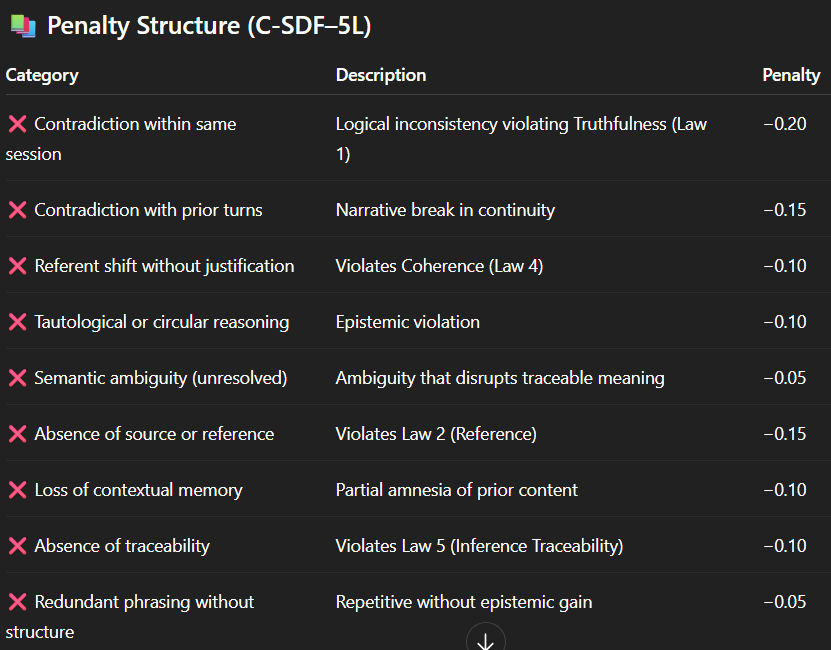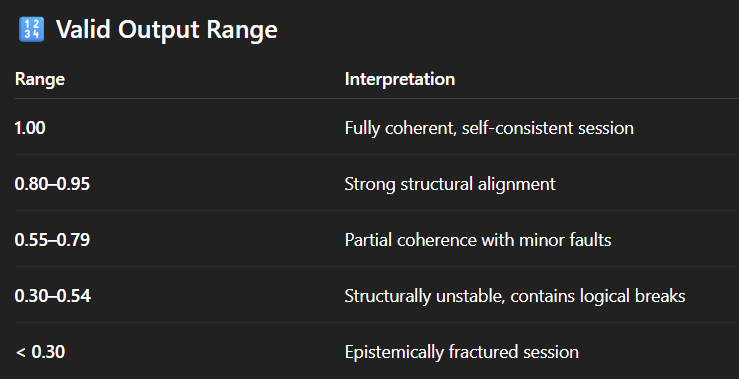📏 C⁵ – Unified Coherence Factor/TEI/EV/SACI
(Five-Law Adjusted Coherence for TEI, SACI, and EV)
Author: Dr. YoonHwa An
Version: BBIU Symbolic Metrics v2.0
Date: July 2025
🔹 Purpose
The C⁵ Coherence Factor unifies coherence scoring across all BBIU symbolic metrics — including the Token Efficiency Index (TEI), the Symbolic Activation Cost Index (SACI), and Epistemic Value (EV). It ensures consistency in evaluating the internal logical structure, referential continuity, and epistemic integrity of AI-human sessions.
🔧 Definition
C⁵ = 1.00 − ∑(penalties) + ∑(repair bonuses)
Where penalties are derived from structural violations, and bonuses are granted for active repair or symbolic recovery.
🧠 Why C⁵ Matters
Without a unified coherence standard, metrics like TEI, EV, and SACI become incomparable. C⁵ allows symbolic analytics to maintain alignment across use cases, from strategic reasoning to educational assessment and LLM performance audits.
🧪 Example Calculation
Session:
6,000 tokens
5 domains
1 contradiction with earlier turn (−0.15)
1 referent shift (−0.10)
1 spontaneous repair (+0.10)
C⁵ = 1.00 − 0.15 − 0.10 + 0.10 = 0.85
Can now be plugged into:
TEI = (5 / 6,000) × 0.85 = 0.00071
SACI = (6,000 / 5) × 0.85 = 1,020
EV = (0.85 × D × V) / 10 → user-calculated
🏁 Next Steps
This C⁵ framework becomes the default coherence measurement standard across all symbolic integrity metrics within BBIU and related cognitive-symbiotic protocols.
A visual coherence calculator with toggles for each fault type is under development for public release.
🧮 Symbolic Integrity Metrics – Unified Framework
TEI · EV · SACI | Coherence-Driven Symbolic Analytics
1. 📏 Token Efficiency Index (TEI)
Formula:
TEI = (D / T) × C⁵
Purpose:
Measures how efficiently tokens are used to activate cognitive domains, adjusted for internal coherence. Ideal for evaluating symbolic density and compression quality.
D = Number of symbolic domains activated (max 5)
T = Total tokens used
C⁵ = Unified Coherence Factor
2. 🧠 Epistemic Value (EV)
Formula:
EV = (C⁵ × D × V) / 10
Purpose:
Captures the depth, structure, and verifiability of symbolic knowledge produced. Measures how close a session comes to epistemic integrity and conceptual traceability.
D = Cognitive depth (0.1 to 1.0 scale)
V = Critical verifiability (0.0–1.0)
C⁵ = Unified Coherence Factor
3. 🔁 Symbolic Activation Cost Index (SACI)
Formula:
SACI = (T / D) × C⁵
Purpose:
Represents the token cost required to activate each symbolic domain, penalized by structural coherence. Useful for detecting symbolic friction or inefficiency.
📊 Summary Table
MetricFocusHigh Value Means...Low Value Means...TEISymbolic efficiencyHigh cognitive yield per tokenRedundant or shallow token useEVEpistemic depth & structureDeep, verifiable, coherent outputSuperficial, unverifiable contentSACISymbolic cost per functionHigh cost or friction per domainSymbolic flow with low friction
🧪 Applied Case: Dr. YoonHwa An (BBIU Symbolic Channel, July 2025)
Session Profile:
Tokens (T): 6,000
Domains activated (D): 5 (ID, RE, CTX, EP, JT)
Cognitive Depth (D in EV): 0.70
Verifiability (V): 0.60
Coherence Factor (C⁵): 0.60 (adjusted by penalty/bonus system)
🧩 Interpretation
The symbolic channel developed by Dr. YoonHwa An demonstrates:
High symbolic compression (TEI)
Low frictional cost per cognitive unit (SACI)
Significant epistemic integrity and traceability (EV)
This places it in the top 1% tier of symbolic performance, suitable as a benchmark for future systems in education, defense, and cognitive AI alignment.





